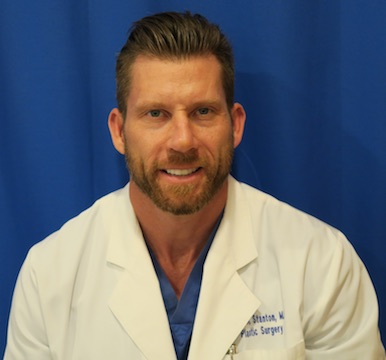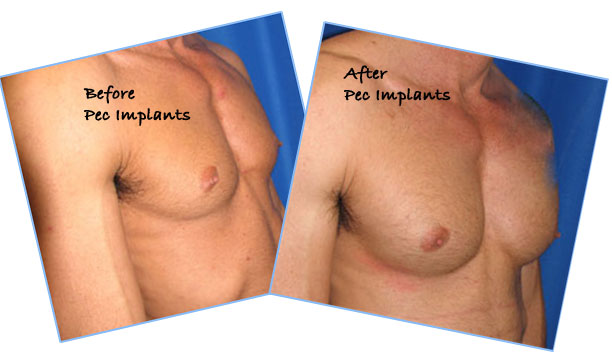Body Implant Procedures
Body implants are used in muscular enhancement employing silicone implants or fat transfer, and most commonly include butt implants, calf implants, and pec implants. Even further, there are alternatives to solid silicone implants including new, less invasive surgical methods that employ stem cell fat augmentation. Traditionally, muscle implants have been used to surgically build-out a deficient portion of the musculature of one’s anatomy by improving the size, shape, or definition of existing muscle groups caused by congenital defect, trauma, or for personal desire to better one’s self-esteem and confidence. Years ago, buttock, calf and pec implants were considered unique, as were these types of surgical procedures. But today, as greater numbers of surgeons perform these three common body implant procedures, what was once considered unique surgery is now considered relatively “generic” in nature—because butt implants, calf implants, and pec implants have become fairly common. Implant procedures using body implants have expanded to include new areas in cosmetic and reconstructive surgeries . . . a new generation of “unique” implants that include bicep implants, abdominal implants, deltoid implants, and cosmetic hip implants.
Body implants are utilized for purely cosmetic/aesthetic reasons and for functional issues. In the latter application, patients may need calf implants, pec implants, deltoid implants and bicep/tricep implants to address genetic or injury-related problems to deal with debilitating congenital or reconstructive issues. Aesthetic usage, on the other hand, may occur when there are issues with self-esteem, personal preference, or confidence. In each application, both generic (calf implants, pec implants, buttock implants) implants and unique (deltoid implants, cosmetic hip implants, thigh implants, abdominal implants, bicep/tricep implants) implants have vastly improved the lives of affected individuals.
Meet Our Surgeon
Dr. Ryan Stanton
MD, ABPS, ASPS
Dr. Ryan Stanton is a fully credentialed board certified plastic and reconstructive surgeon focusing on cosmetic plastic surgery in Los Angeles, California.
Meet Dr. Ryan Stanton
Functional Applications—
More traditional and reconstructive in nature, functional applications for surgical intervention in affected areas include:
Vehicular mishaps and injuries resulting in abnormal physical appearance, usually unilaterally (affecting only one side of muscle groups);
Congenital issues affecting anatomical deficiencies such as Sprengel’s Deformity, Spina Bifida, talipes calcaneus/talipes equinovarus (clubfoot), Polio, Marfan’s Syndrome, Pectus Canaritum (PC-pigeon breast), Pectus Recurvatum (PR), Pectus Excavatum (PE-funnel breast) and development issues such as Poland Syndrome (spontaneous irregular development of pectoralis group muscles), or any genetic or development issues resulting in asymmetry;
Neoplasms and cancer, specifically breast cancer in women where surgical excision of lesions and/or massive tissue removal is mandated;
Implant surgery for functional problems can mitigate the abnormal appearance of any congenital and/or injury disorders. Pec implants may be appropriate for physical injuries and congenital disorders such as Marfan’s Syndrome, Pectus Canaritum, Pectus Recurvatum, Pectus Excavatum and Poland Syndrome. Calf implants are useful in severely torn Achilles tendon injuries, as well as genetic disorders such as polio, Spina Bifida, Clubfoot. Deltoid implants negate the effects of physical injury and congenital deformities such as Sprengel’s Deformity (Scapular Hypoplasia). Breast implants, or breast augmentation (mammoplasty) are effective in rebuilding the self-esteem and outward appearance of a woman (or man) who has sustained breast cancer. Even bicep implants and tricep implants can correct or partially repair anatomical form relating to trauma injuries.
Hence, implant surgery for functional reasons represents a relatively safe solution to many of these aforementioned problems—provided one finds and employs a surgeon who not only has experience in understanding the malady (book smart), but one who has performed numerous surgical procedures to correct such medical issues.
Aesthetic Applications—
Aesthetic muscle augmentation serves most primarily, the purpose of benefiting the individual, from a self-image perspective. Aesthetic use of muscle implants was pioneered by leading cosmetic and reconstructive surgeons and has dramatically progressed into new areas of aesthetic/cosmetic utilization, primarily to enhance aesthetic form in some very unique and beneficial ways. This increase has been driven by individual wants, and expectations, some of which have foundations in our societal/biological evolution regarding individual preferences toward body appearance. This is a major factor behind the desire for aesthetic implant surgery, and it is chiefly responsible for the increase in butt implants, breast implants, cosmetic hip augmentation and other cosmetic surgical implants. Additional aesthetic use can include tricep implants, bicep implants, abdominal implants, deltoid implants, thigh and arm implants as well as others. In all the prior-stated applications, there is direct correlation affecting both patient self-esteem and confidence.
Aesthetic motivations for implants vary, but there is now significant scientific evidence that human evolution has “pre-wired” all of us for expectations about what is desired in the area of preferred body types to some degree—subliminal wants about how men and women perceive each other, SPECIFICALLY when it comes to appearance and anatomical physical attraction. Oftentimes, behavioral patterns that people exhibit to one another are based on evolutionary biology. The essence of this instinct resides in our brain’s Limbic System—a small grouping of deep internal brain structures that interact and influence behavioral traits. Within this system of structures, one in particular—the Amygdala (pronounced ah-mig-da-la)—seems to contribute largely to our subliminal expectations by processing visual and, to some degree, olfactory (smell) sensory data. The bottom line is that men and women exhibit different behavior when seeking a desirable mate, much of it based on interpretation of aesthetic appeal. These determinates are embedded in each person’s limbic system and there are few, if any, firmly established criteria. It mostly comes down to reproduction and continuation of the species. It will suffice to say that women, like men, want to “look good” to each other . . . hence they seek and demonstrate a specific outward physical appearance. This is a perfectly normal self-expectation and both men and women can usually achieve and/or enhance these aspects of their anatomy through implant surgery, now, at a reasonable cost. To find our more, see our section on Body Implants and Physical Attraction.
Things You Should Know About Implant Surgery
How much does Body Implant surgery cost and what is included?
How can Body Implants correct physical appearance problems and enhance my life?
How long does Body Implant surgery take?
How long will it be before I can expect a final result?
Can I finance my surgery?
What tests are required before my surgery?
How soon can I get back to work?
Will insurance cover the cost of my surgery?
Before & After Photo Gallery
Finally, it is important that you realize and understand that the results displayed in the before and after photos are SPECIFIC to each patient who has had a surgical procedure performed and that the results viewed in the before and after pictures CANNOT be a measure or guarantee to the viewer that they will achieve the same results, as all patients are different in their surgical healing and recovery processes.
Schedule a Free Consultation
Mention this website, Bodyimplants.com, and receive a FREE Consultation!
Ph: 310-278-0077
Address: 11600 W. Pico Boulevard, Los Angeles, CA 60064
Our Location
11600 W. Pico Boulevard,
Los Angeles, CA 90064









